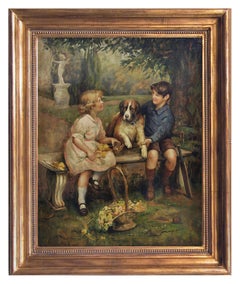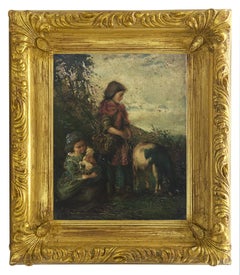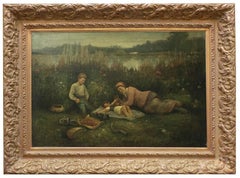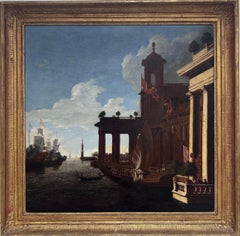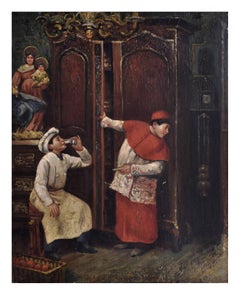Jean Philipe Moreno Art
to
2
1
1
Overall Width
to
Overall Height
to
4
2
1
3
1
4
3
2
2
2
1
1
1
1
4
4
4
4
4
8,816
2,808
1,655
1,313
1
4
4
Artist: Jean Philipe Moreno
CHILDREN WITH DOG - English School - Italian Figurative Oil on canvas Painting
By Jean Philipe Moreno
Located in Napoli, IT
Children with dog Jean Philipe Moreno Italia 2002 Oil on canvas mis. cm. 70x55
Moreno is a traditional painter who observes and studies the great masters of the 18th century, together with his own personality he creates original works with mastery and artistic skill.
This is a reinterpretation of the London Master Arthur John Elsley...
Category
Early 2000s English School Jean Philipe Moreno Art
Materials
Canvas, Oil
COUNTRY SCENE- Neapolitan School Italian Figurative Oil on Canvas Painting
By Jean Philipe Moreno
Located in Napoli, IT
COUNTRY SCENE - Oil on canvas cm.30x24 by Jean Philipe Moreno, Italy 2002.
Frame available on request from our workshop.
The painting by Jean Philipe Moreno depicts a bucolic scene. Moreno is inspired by the paintings of the Neapolitan School of the 1800s and in particular by the Neapolitan painter Filippo Palizzi...
Category
2010s Old Masters Jean Philipe Moreno Art
Materials
Canvas, Oil
SPRING PORTRAIT- French School Impressionist - Italian Oil on Canvas Painting
By Jean Philipe Moreno
Located in Napoli, IT
SPRING PORTRAIT - Oil on canvas cm.30x24 by Jean Philipe Moreno, Italy 2002.
Frame available on request from our workshop.
Moreno’s portrait depicts a young Parisian woman, her face ...
Category
2010s Old Masters Jean Philipe Moreno Art
Materials
Canvas, Oil
BREAKFAST ON THE LAWN - Impressionist Italian Figurative Oil on canvas painting
By Jean Philipe Moreno
Located in Napoli, IT
breakfast on the lawn Jean Philipe Moreno Italia 2002 Oil on canvas mis. cm. 60X90
Jean Philipe Moreno’s painting depicts a green and flowery landscape, a family refreshing themse...
Category
Early 2000s Impressionist Jean Philipe Moreno Art
Materials
Canvas, Oil
Related Items
Huge Classical Old Master Oil Painting Ancient Roman Buildings Merchants Port
Located in Cirencester, Gloucestershire
The Ancient Trading Port
Italian Old Master, 18th century
unsigned
oil painting on canvas, in antique gilt frame of beautiful quality
canvas: 32 x 33 inches
framed: 37 x 38 inches
co...
Category
18th Century Old Masters Jean Philipe Moreno Art
Materials
Canvas, Oil
$6,438
H 37 in W 38 in D 2 in
18th Century Neoclassical Oil Painting of the Trojan War: Briseis & Achilles
By James Thornhill
Located in London, GB
James Thornhill (1674-1735)
Oil on canvas
12 x 14 inches;
16 ½ x 18 ½ in. Inc. frame
The subject matter and inclusion of herms on both sides shows the influence of Louis...
Category
Early 18th Century Old Masters Jean Philipe Moreno Art
Materials
Canvas, Oil
$24,656
H 16.5 in W 18.5 in
Very Large 1700's Dutch Old Master Oil Painting The Nativity Scene
Located in Cirencester, Gloucestershire
The Nativity
Dutch Old Master, early 1700's period
oil on canvas, unframed
canvas: 36 x 27.5 inches
provenance: private collection
condition: very good and sound condition, some scuf...
Category
Early 18th Century Old Masters Jean Philipe Moreno Art
Materials
Oil, Canvas
$3,972
H 36 in W 27.5 in
19th Century English Antique, Two Country farmers drinking beer in a landscape
By George Morland
Located in Woodbury, CT
Attributed to George Morland.
19th Century English Antique, Two Country farmers drinking beer in a landscape.
Wonderful early 19th-century original oil on canvas.
A classic 'Morland' composition as the painter was a big fan of English Pub scenes...
Category
Early 1800s Old Masters Jean Philipe Moreno Art
Materials
Canvas, Oil
$3,160 Sale Price
20% Off
H 20 in W 16 in
Judith with the Head of Holofernes, Antique Oil Painting after Cristofano Allori
By Alessandro di Cristofano Allori
Located in Berlin, DE
Judith with the head of Holofernes, antique oil painting after Cristofano Allori.
Painting has been restored.
Dimensions without f...
Category
18th Century Old Masters Jean Philipe Moreno Art
Materials
Canvas, Oil
$6,639 Sale Price
20% Off
H 35.44 in W 27.56 in
Large British Sporting Oil Painting Jockey on Racehorse in Landscape Gilt Frame
By British Sporting Art
Located in Cirencester, Gloucestershire
Jockey on Horseback
British School, 20th century
painted after an earlier style
oil on canvas, framed
framed: 31 x 35 inches
canvas: 20 x 24 inches
provenance: private collection, UK...
Category
20th Century English School Jean Philipe Moreno Art
Materials
Oil
Portrait of Lady Caroline Price
By George Romney
Located in Miami, FL
DESCRIPTION: Perhaps the best Romney in private hands. If Vogue Magazine existed in the late 18th century, this image of Lady Caroline Price would be ...
Category
1970s Old Masters Jean Philipe Moreno Art
Materials
Oil, Canvas
Fine 17th Century Dutch Old Master Oil Painting Interior Scene Many Figures
Located in Cirencester, Gloucestershire
Alms for the Poor
by Richard Brakenburg (Flemish 1650-1702)
oil on canvas, unframed
Canvas: 25 x 30 inches
Provenance: private collection, France, extensively inscribed verso
Conditi...
Category
17th Century Old Masters Jean Philipe Moreno Art
Materials
Oil, Canvas
The Knight - painting - XVII century
Located in Roma, IT
The Knight is an original oil painting on canvas realized during the XVII century by an anonymous artist.
Provenance: Pecci-Blunt collection. Good condition...
Category
17th Century Old Masters Jean Philipe Moreno Art
Materials
Canvas, Oil
18th century French Garden or Féte a Bride and musicians playing music
Located in Woodbury, CT
This enchanting 18th-century French fête galante captures the elegance and joy of aristocratic leisure, set amidst a lush garden adorned with flowers. A scene of refined celebration,...
Category
1780s Old Masters Jean Philipe Moreno Art
Materials
Canvas, Oil
Bords de Seine aux Andelys
By George Binet
Located in LE HAVRE, FR
Georges BINET (1865-1949)
Bords de Seine aux Andelys, 1905
Oil on canvas
Size: 21 x 33 cm
Signed and dated lower right
Painting in perfect condition.
Old gilded frame (some small chi...
Category
Early 1900s Impressionist Jean Philipe Moreno Art
Materials
Canvas, Oil
Fine British Aristocratic Portrait of a Nobleman Lord Jeffreys of Wem
Located in Cirencester, Gloucestershire
Portrait of Lord Jeffreys of Wem
British School, 20th century (presumably after an earlier work)
oil painting on canvas, framed
framed: 30.5 x 24.5 inches
canvas: 26 x 20 inches
prov...
Category
20th Century Old Masters Jean Philipe Moreno Art
Materials
Oil, Canvas
$1,369
H 35.5 in W 28.5 in
Previously Available Items
THE WINE OF THE MASS
By Jean Philipe Moreno
Located in Napoli, IT
The wine of the Mass - Jean Philipe Moreno Italia 2002 - Oil on canvas cm. 50x40
Category
Early 2000s Old Masters Jean Philipe Moreno Art
Materials
Canvas, Oil
Jean Philipe Moreno art for sale on 1stDibs.
Find a wide variety of authentic Jean Philipe Moreno art available for sale on 1stDibs. You can also browse by medium to find art by Jean Philipe Moreno in canvas, fabric, oil paint and more. Much of the original work by this artist or collective was created during the 21st century and contemporary and is mostly associated with the Old Masters style. Not every interior allows for large Jean Philipe Moreno art, so small editions measuring 10 inches across are available. Customers who are interested in this artist might also find the work of Giulio Di Sotto, Pietro Colonna, and Matthew Cook. Jean Philipe Moreno art prices can differ depending upon medium, time period and other attributes. On 1stDibs, the price for these items starts at $1,592 and tops out at $3,075, while the average work can sell for $2,158.
